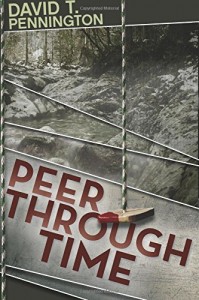
Taking refuge with a woman named Lasha, they eventually begin to share their secrets: they can both hear voices. When her cybernetic implants malfunction, Carmela receives a message through time of a string of murders, and her sister begins following the final footsteps of deceased childhood friend and convicted murderer Eric Drake with Carmela’s psychotherapist android Kass. Across a gap of 143 years, together they begin to unravel the secret of Peer Industries, and question their enemies and allies across the past and present in Peer Through Time by David T. Pennington.
The most pressing issue with Peer Through Time is that it’s a very busy book; the story jumps around a lot between characters, times, and places, jumbling a story that already weaves a complex, winding narrative with ideas that transcend current popular scientific theories. Many aspects are left at least initially unexplained, without particular hints as to why these things are possible, mostly to do with cybernetics and other taken-for-granted future technology.
While Pennington clearly intends to make the world a little bit more realistic by passing these advances off casually, it causes convolution when trying to figure out the mysteries the book truly wants the reader’s focus on, these questions themselves very much abstract in their solution also. The gaps of knowledge are by no means insurmountable, but in the end every chapter starts and ends with a nagging sense of missing out in a way that turns against pushing forward with the more interesting hooks in the story. Despite presenting a bumpy road for readers, the book is quite original and takes very unique turns with its problems.
The characters, while not all especially distinct, have certain arcs in what they do that converge across the timelines they find themselves in, and there’s a slow boil of intrigue as answers seem to only open more questions until the very last pages. The tech’ involved in the book is fairly usual for a sci-fi novel, but implemented with a sense of consequence and as a thoughtful development of current trends without becoming silly, referential, or sneering toward modern-day culture. This obviously pulls back to the 1930s time-travel, where the entire progression of past-to-present is blended and developed quite successfully, without period inertia or all-too-common logical incongruity.
Peer Through Time is quirky, but sensible; the book is interesting as a whole, but it might be difficult for many readers to get past the constant time-warps, both in plot and in narrative. The book presents itself well, and beyond its unfortunate disclarity is a sophisticated plot melding sci-fi and 1930s America in a bold and refreshing way. If the mystery seems worth the effort, Peer Through Time is a very decent read.
Review Overview
Content
Design
Editing
Get an Editorial Review | Get Amazon Sales & Reviews | Get Edited | Get Beta Readers | Enter the SPR Book Awards | Other Marketing Services























Leave A Comment